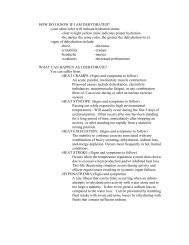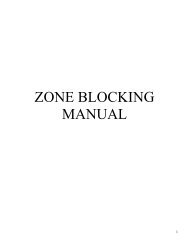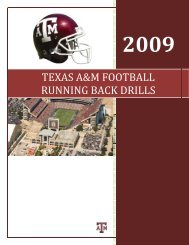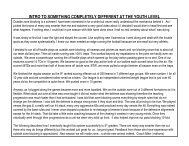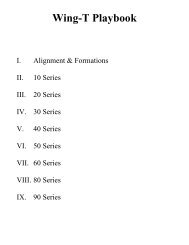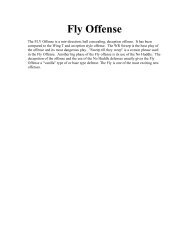You also want an ePaper? Increase the reach of your titles
YUMPU automatically turns print PDFs into web optimized ePapers that Google loves.
hard. If your 1L succeeds in stopping the Wedge cold, there is every chance therefs will whistle the play dead before a crack ever appears. That's defensivefootball.The Trap, especially off Spin action, requires similar restraint by your Coredefenders. Once again, your 1L is subject to double- and triple-teaming on thisplay, so must submarine and build a pile when they feel that pressure. Mike andWill will most likely face angle blocks, and must fight to hold their position. Thelineman being trapped should stay low and look for the trapper out of hisperipheral vision. I favor turning the defender's shoulders to face the oncomingtrap block, but I know other coaches disagree with that technique. Theimportant thing is that you are prepared to face the Trap through repetition inpractice. Again, this is a slower-evolving play than the T-formation quick trap.Your 2L defenders will have time to read and react, as long as they don’t gocharging ahead to "make things happen" before carefully diagnosing the play.Finally, there is the weak-side game -- inside, off-tackle, and outside reverses.These can come from straight series (tailback starts off strong and hands to thewingback heading weak) or spin action (fullback initiates the play with a full spinbefore handing to wingback heading weak). The play of the Backside End iscrucial to containing this threat. Ron (or Len against a Single <strong>Wing</strong> LeftFormation) should alert with a call of "CRACK-CRACK" if the split end attempts toclip the Backside End. If Mike and Will are reading their key triangles properly,they should either be: 1) holding position in the middle waiting for a Trap orCounter to develop, which will put them in better position to play the outsidereverse than if they had followed the tailback to the strong side, and in perfectposition to fight the off-tackle or inside reverse; or 2) following the guards andblocking back to the weak side, forming a seamless wall along with the BacksideEnd for the reverse to crash into.The drop-back passing game is not the strong point of most Single <strong>Wing</strong>offenses -- if this was a good passing team you were facing, they'd be in ashotgun or spread formation, not bunched in tight. Nevertheless, you should beprepared to follow certain rules. The Single <strong>Wing</strong> is well adapted to forming apassing pocket, so your Ends should remain concerned with containment even asthey rush the tailback (or fullback, in some Single <strong>Wing</strong> offenses). The minimalsplits between offensive linemen mean your best bet for pressure will come fromthe corners rather than up the middle -- consider Cushion and Switch blitzes (p.31). Otherwise, mix up straight Cover to account for play-action passes withMax. A Single <strong>Wing</strong> offense can’t easily send four men deep without resorting tomotion and tipping their hand. Your Deep Safety is your best insurance againstthe "home-run ball" being completed. He will find after a few drop-back passesthat the Single <strong>Wing</strong> is a fairly predictable passing formation, and that he will getgood reads all day long from the tailback or fullback passing the ball.86




